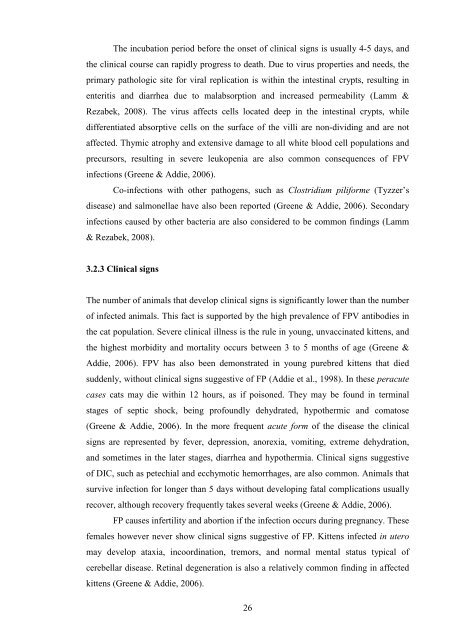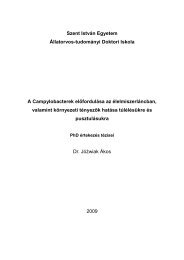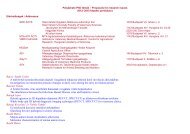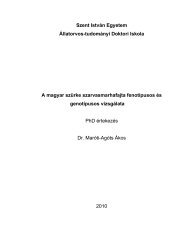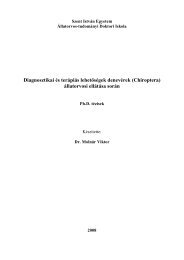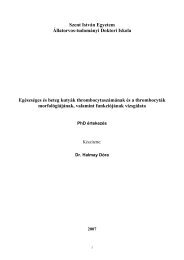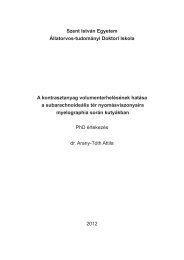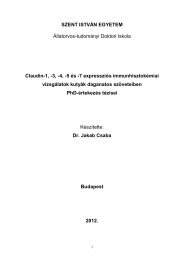PhD Thesis Demeter Zoltan
PhD Thesis Demeter Zoltan
PhD Thesis Demeter Zoltan
You also want an ePaper? Increase the reach of your titles
YUMPU automatically turns print PDFs into web optimized ePapers that Google loves.
The incubation period before the onset of clinical signs is usually 4-5 days, and<br />
the clinical course can rapidly progress to death. Due to virus properties and needs, the<br />
primary pathologic site for viral replication is within the intestinal crypts, resulting in<br />
enteritis and diarrhea due to malabsorption and increased permeability (Lamm &<br />
Rezabek, 2008). The virus affects cells located deep in the intestinal crypts, while<br />
differentiated absorptive cells on the surface of the villi are non-dividing and are not<br />
affected. Thymic atrophy and extensive damage to all white blood cell populations and<br />
precursors, resulting in severe leukopenia are also common consequences of FPV<br />
infections (Greene & Addie, 2006).<br />
Co-infections with other pathogens, such as Clostridium piliforme (Tyzzer’s<br />
disease) and salmonellae have also been reported (Greene & Addie, 2006). Secondary<br />
infections caused by other bacteria are also considered to be common findings (Lamm<br />
& Rezabek, 2008).<br />
3.2.3 Clinical signs<br />
The number of animals that develop clinical signs is significantly lower than the number<br />
of infected animals. This fact is supported by the high prevalence of FPV antibodies in<br />
the cat population. Severe clinical illness is the rule in young, unvaccinated kittens, and<br />
the highest morbidity and mortality occurs between 3 to 5 months of age (Greene &<br />
Addie, 2006). FPV has also been demonstrated in young purebred kittens that died<br />
suddenly, without clinical signs suggestive of FP (Addie et al., 1998). In these peracute<br />
cases cats may die within 12 hours, as if poisoned. They may be found in terminal<br />
stages of septic shock, being profoundly dehydrated, hypothermic and comatose<br />
(Greene & Addie, 2006). In the more frequent acute form of the disease the clinical<br />
signs are represented by fever, depression, anorexia, vomiting, extreme dehydration,<br />
and sometimes in the later stages, diarrhea and hypothermia. Clinical signs suggestive<br />
of DIC, such as petechial and ecchymotic hemorrhages, are also common. Animals that<br />
survive infection for longer than 5 days without developing fatal complications usually<br />
recover, although recovery frequently takes several weeks (Greene & Addie, 2006).<br />
FP causes infertility and abortion if the infection occurs during pregnancy. These<br />
females however never show clinical signs suggestive of FP. Kittens infected in utero<br />
may develop ataxia, incoordination, tremors, and normal mental status typical of<br />
cerebellar disease. Retinal degeneration is also a relatively common finding in affected<br />
kittens (Greene & Addie, 2006).<br />
26


